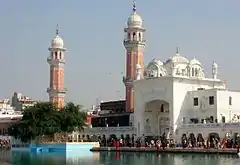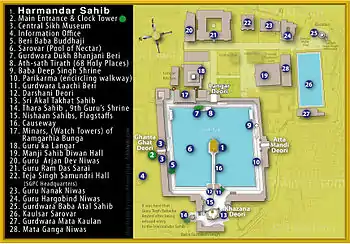Ramgarhia Bunga
Ramgarhia Bunga or Burj is the three-storeyed red stone watchtowers complex located near southeastern edge of the Golden Temple, Amritsar.[1] The two minaret-style Ramgarhia Bunga high towers are visible from the parikrama (circumambulation) walkway around the Harmandir Sahib Sarovar (water tank).[2] It is a pre-Ranjit Singh structure built by Sikh warrior and Ramgarhia misl chief Jassa Singh Ramgarhia in late 18th-century,[3][4] after the 1762 destruction and desecration of the Sikh holy temple and site by the Afghan Muslim forces led by Ahmed Shah Abdali.[1] The Bunga watchtowers-related infrastructure was constructed to station sentinels to watch for any surprise attack, house soldiers to help fortify the area, and to protect the holy complex from desecration.[1][5]


The Ramgarhia Bunga houses the granite slab of Takht-e-Taus[6] from the Red Fort on which, according to the oral tradition, all the Mughal emperors were crowned in Delhi. This slab was seized by Sikhs from Delhi, during an attack against the Mughal armies, and brought back to Amritsar as a symbol that the Mughal Empire will end with the removal of their coronation stone.[1]
History

During the reign of the Muslim Mughal Emperors, The Golden Temple was damaged many times, but each time it was rebuilt by the Sikhs. Sardars of the 12 Sikh Misls decided that some of the Khalsa leaders must be housed inside it for its protection against their enemies. According to Fenech and McLeod, during the 18th century, Sikh misl chiefs and rich communities built over 70 such Bungas of different shapes and forms around the Golden Temple to watch the area, house soldiers and defend the temple.[5] Such Bungas were also built near major Sikh shrines elsewhere on the Indian subcontinent in the 18th-century.[5] In the 19th century, these served defensive purposes, provided accommodation for Sikh pilgrims and some served as centers of learning.[5] Most of the Bungas were demolished during and after the British colonial era, often to improve the facilities for growing number of pilgrims in the 20th-century. The Ramgarhia Bunga is single surviving example of the Bunga-related historic infrastructure in Amritsar,[1] along with Akal Takht which originally was built as the Akal Bunga on the other side of holy tank.[5]
Ramgarhia misl chief Jassa Singh Ramgarhia had conquered territory as far afield as Delhi, where he removed the slab from the Takht-e-Taus on which the Mughal coronation ceremonies were held. He brought the slab to Amritsar and placed it in the Ramgarhia Bunga where it still lies.
Architecture

Ramgarhia Bunga consists of three flat-roofed ranges, each of two principal storeys, arranged round three sides of a courtyard and is constructed almost of small burnt bricks (Nanakshahi) set in lime and mud mortar.[7] The colonnade and the triple arches are of red sandstone. The undersides of the vaults and all the walls were finished internally and externally with lime plaster and lime wash, much of it decorative with arches. Lower levels are approached by two flights of steps, one from outside and the other from within the courtyard.
Ramgarhia misl
Ramgarhia misl chief Jassa Singh Ramgarhia was a brave Sikh leader. He had redesigned[8] a mud fortress Ram Rauni in 1748 about a mile from Golden Temple which was used to house and keep soldiers.[9] The place was named so in honour of fourth Sikh Guru Shri Guru Ram Das Ji, who have founded the Amritsar city. The place was later known as Quila Ramgarh due to its fortification by Jassa Singh Ramgarhia. The Ramgarhia Misl derives its name from this place which literally means Custodians of the Castle of God.[10] The Quila Ramgarh has already lost its very existence and its location is adjacent to Gurudwara Sri Ramsar Sahib and Guru Ramdas Khalsa Senior Secondary School on Ramsar Road, Amritsar.
Ramgarhia bunga remains a symbol of the Ramgarhia Sikh community's identity, their historic sacrifices and contribution to defending the Golden Temple over the centuries.[11]
Renovation
The original domes on the minarets were damaged and then removed in 1903 because of an earthquake. The minarets were again heavily damaged by Indian artillery fire during Operation Blue Star in 1984,[12][13] but later renovated by the Shiromani Gurdwara Parbandhak Committee[14] and the Ramgarhia Society Sardar Jassa Singh Ramgarhia Federation.[7][15] Later, some Babas of Kar Sewawale had done colossal damage to the heritage site by converting a portion into their abode.[16] There are also plans to convert basement of bunga to Sikh museum.[17]
See also
Photo gallery
 Location of bunga in Darbar sahib complex (no. 17)
Location of bunga in Darbar sahib complex (no. 17) Golden Temple in year 1880
Golden Temple in year 1880 Bunga visible behind Golden Temple in 1870
Bunga visible behind Golden Temple in 1870 Golden temple view from Ramgarhia bunga
Golden temple view from Ramgarhia bunga Darbar Sahib night view
Darbar Sahib night view Slab of Mughal throne placed in Bunga[18]
Slab of Mughal throne placed in Bunga[18] Bunga as seen from main entrance of Golden Temple
Bunga as seen from main entrance of Golden Temple
.JPG.webp)


.JPG.webp)




.jpeg.webp)



References
- The Golden Temple, Punjab Heritage and Tourism Promotion Board, Government of Punjab, India
- Pashaura Singh; Louis E. Fenech (2014). The Oxford Handbook of Sikh Studies. Oxford University Press. p. 435. ISBN 978-0-19-969930-8.
- "sikhchic.com | The Art and Culture of the Diaspora | Restoration of The Bunga Ramgharia". www.sikhchic.com.
- "Untitled Document".
- Louis E. Fenech; W. H. McLeod (2014). Historical Dictionary of Sikhism. Rowman & Littlefield Publishers. pp. 74–75. ISBN 978-1-4422-3601-1.
- "ਜੱਸਾ ਸਿੰਘ ਰਾਮਗੜ੍ਹੀਆ ਦੀ ਅਨਮੋਲ ਨਿਸ਼ਾਨੀ : ਬੁੰਗਾ ਰਾਮਗੜ੍ਹੀਆ". Tribuneindia News Service.
- "The Tribune, Chandigarh, India - Punjab". www.tribuneindia.com.
- "Ram Rauni". 19 December 2000.
- Parm B Singh (1999). Golden Temple. Punjabi University. p. 23. ISBN 978-81-7380-569-1.
- "The Tribune, Chandigarh, India - Amritsar PLUS".
- Pashaura Singh; Norman Gerald Barrier (1999). Sikh Identity: Continuity and Change. Manohar. p. 264. ISBN 978-81-7304-236-2.
- "tribuneindia... Punjab". www.tribuneindia.com.
- Pandey, Hemant Kumar; Singh, Manish Raj (2017). INDIA'S MAJOR MILITARY & RESCUE OPERATIONS. Horizon Books ( A Division of Ignited Minds Edutech P Ltd). p. 154. ISBN 978-9386369390.
- "Conservsation of Ramgarhia Bunga". Archived from the original on 10 October 2008.
- "6 साल से अटके रामगढ़िया बुंगा की मरम्मत शुरू हाेने की उम्मीद". Dainik Bhaskar. 16 May 2019.
- "The Tribune, Chandigarh, India - Punjab". www.tribuneindia.com.
- "Bunga Ramgarhia to be converted into museum". 8 May 2010.
- https://kunalkhurana.com/amritsar-2018/
External links
![]() Media related to Ramgarhia Bunga at Wikimedia Commons
Media related to Ramgarhia Bunga at Wikimedia Commons